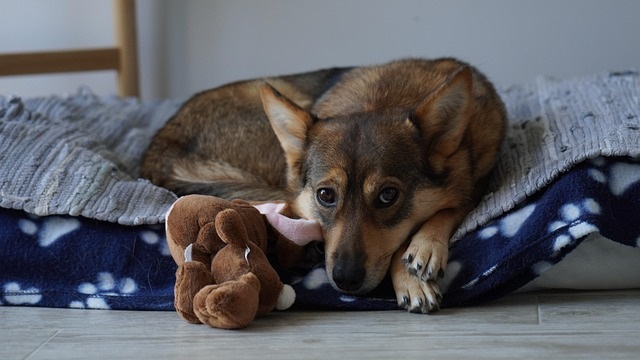Home Remedies to Stop Your Dog from Licking Their Paws: What Works and When to See a Vet
Does the sound of your dog constantly licking and chewing their paws have you worried? You’re not alone.
Paw licking is a common behavior, but excessive licking can mean your pup isn’t feeling well. Before you rush to the vet, there is a game-changing question to ask: “Is there a home remedy to stop a dog from licking paws?”
For many minor issues, the answer is yes.
This guide will walk you through safe, effective home remedies, help you identify the potential cause, and, most importantly, provide a clear roadmap for when to seek professional help.
Key Takeaways
- Many common causes of paw licking can be managed at home.
- The key is to identify what is making your dog lick their paws.
- Track your dog’s behavior with a pet health tracker to know if it’s working.
- When in doubt, take your pet to the vet.
Why Do Dogs Lick Their Paws?
Understanding the “why” behind the licking is the first step toward a solution. Some of the most common reasons for a dog to lick their paws include:
- Allergies: This is one of the most common causes. Environmental allergens like pollen, grass, dust mites, or certain foods can cause itchy skin, which dogs try to relieve by licking.
- Pain: A dog may lick a paw to soothe pain from an injury, like a cut, splinter, or even an insect sting. Arthritis can also cause discomfort, leading to licking.
- Anxiety or Boredom: Compulsive licking can be a behavioral issue. Dogs lick their paws as a way to self-soothe when they’re stressed, anxious, or bored.
- Dry Skin: Especially in dry climates, your dog’s paws can become cracked and itchy, prompting them to lick.
- Infections: Paws are a prime location for yeast and bacteria to thrive, especially between the toes. Look for classic signs, such as a yeasty odor, redness, and brownish staining on the fur.
How to Stop Dog from Licking Paws: Home Remedy Options
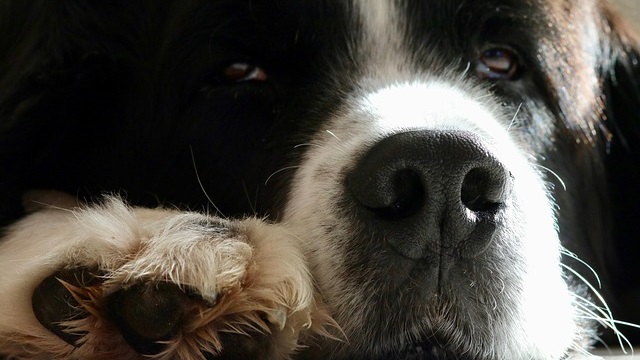
Once you have a possible cause in mind, you can try targeted home remedies for your dog’s itchy paws. But keep in mind that these solutions are most effective for non-severe cases.
Best Home Remedies for Dog Itchy Paws
Epsom Salt Soak
For minor cuts, bruises, or muscle soreness, a warm Epsom salt soak can work wonders. Dissolve a tablespoon of Epsom salt in a gallon of warm water and have your dog stand in it for 5-10 minutes. At the end, rinse thoroughly.
Wipes for Allergen Removal
After walks, use a damp cloth or a pet-safe wipe to clean your dog’s paws. This removes pollen, grass, and other environmental allergens before they can cause an allergic reaction.
Dietary Adjustments
This takes longer to be effective, but adding a good quality pet brand of fish oil to your dog’s diet can help improve the skin barrier, reducing dryness and itching. If you suspect food allergies, speak with your vet about a hypoallergenic diet.
“I got the Maven sensor for my 14-year-old Chihuahua mix with heart and trachea issues. It gave me back peace of mind – I can track her RRR, BPM, drinking, and activity anytime and know instantly if something’s wrong. Highly recommend!”

★★★★★
Chiara De Luca
Titti
Oatmeal Baths
Colloidal oatmeal soothes irritated skin and reduces inflammation. You can use oatmeal pet shampoos or other oatmeal bath packets. Prepare a bath in cool to lukewarm water and soak your pet’s paws for 5 to 10 minutes, rising thoroughly at the end. You can do this every day. In case of full baths, don’t do it more than two times per week.
Apple Cider Vinegar
The acetic acid in cider vinegar is a powerful anti-bacterial and anti-fungal treatment. Mix 50:50 with water and spray or soak your dog’s paws. Be careful not to use full strength vinegar on your pup’s skin, and if you see any open wounds or raw skin, do not apply the vinegar as well, as it can be extremely painful and make things worse.
Chamomile or Green Tea Soak
These teas have soothing properties and can help soothe irritated skin. Prepare the tea and let it cool completely. Then, apply directly to the skin using a compress for around 5 minutes.You can also prepare tea in a basin or tub, for example, and soak your pet’s paws in the tea.
When Home Remedies Aren’t Enough
“Many cases of paw licking can be managed at home—if you catch them early and track the pattern. If symptoms worsen or persist, that’s your cue to consult a vet.” — Carolina Domingues, DVM.
While home remedies are a great first step, they are not a cure-all. You should always be on the lookout for signs that the problem is more serious.
Contact your vet immediately if you notice any of the following:
- Severe redness, swelling, or heat in the paw.
- Bleeding, pus, or foul odor coming from the paw.
- Obvious signs of pain, like limping.
- Persistent licking.
- Home remedies haven’t helped after a few days of consistent use.
Why It’s Important to Track Paw Licking Over Time
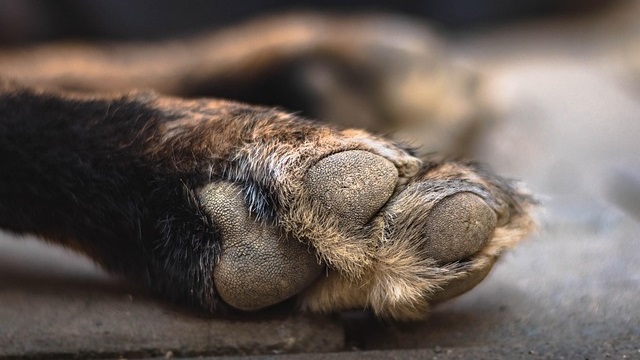
How can you be sure if a home remedy is actually working?
The answer is behavior tracking. Monitoring your dog’s behavior over time helps you see patterns and make informed decisions.
A dog health tracker can help you:
- Document when and how often your dog is licking their paws.
- Note any other symptoms, such as limping or redness.
- Record the home remedies you’ve tried and their effectiveness.
- Gather a clear log of symptoms to share with your vet, saving time and helping them make a more accurate diagnosis.
How Maven Helps You Monitor Paw Irritation and Recovery
Maven allows you to easily track your dog’s health. You can create a detailed log of your dog’s paw-licking episodes, including the time of day, duration, and any accompanying symptoms.
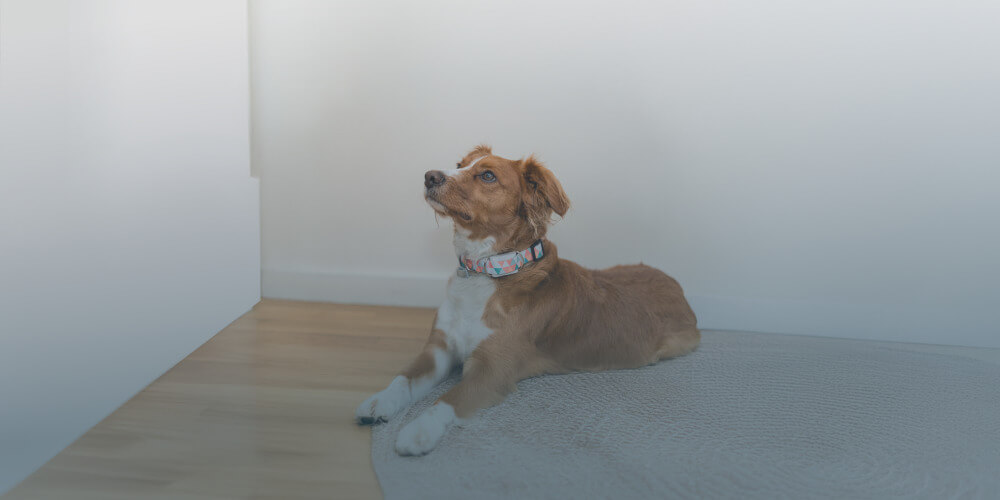
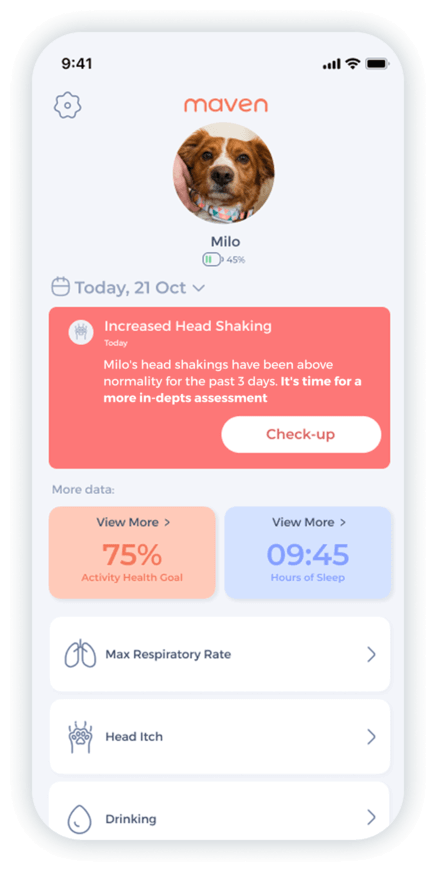
Monitor heart rate, respiratory rate, activity & rest, drinking, itch behavior.
Using Maven’s pet collar, you can:
- See a clear trend: Is the licking becoming less frequent or more intense? Visualizing the data helps you answer this question with certainty.
- Connect the dots: Did the licking start after a walk in a new park? Was it a new food you introduced? Maven helps you link behaviors to potential triggers.
- Share data with your vet: You can easily export your detailed health logs and behavioral notes to share with your veterinarian. This data-centered approach helps your vet make a more informed diagnosis and treatment plan.
Takeaways Recap
- Causes for itchiness range from allergies and behavioral issues to pain and infections.
- Start with safe, vet-approved home remedies and track your dog’s response.
- If the licking is persistent, or you notice signs of pain, swelling, or infection, it’s time to see your vet.
- Use a tool like Maven to track the frequency and severity of paw licking. This data is invaluable for determining if your home remedy is working and for sharing with your veterinarian.
Maven Pet focuses on improving the quality of life of our pets with technology, using artificial intelligence (AI) to enable proactive pet care. By accurately collecting and monitoring pet data 24/7 and flagging any irregularities, Maven Pet empowers pet parents and veterinarians to stay ahead of potential health issues, ensuring the well-being and longevity of our beloved companions.

